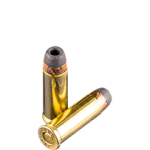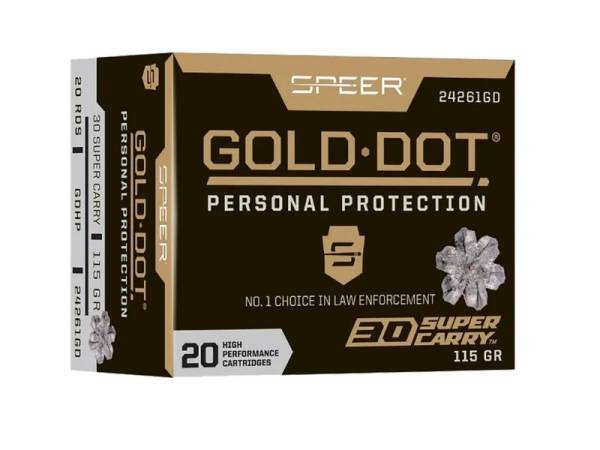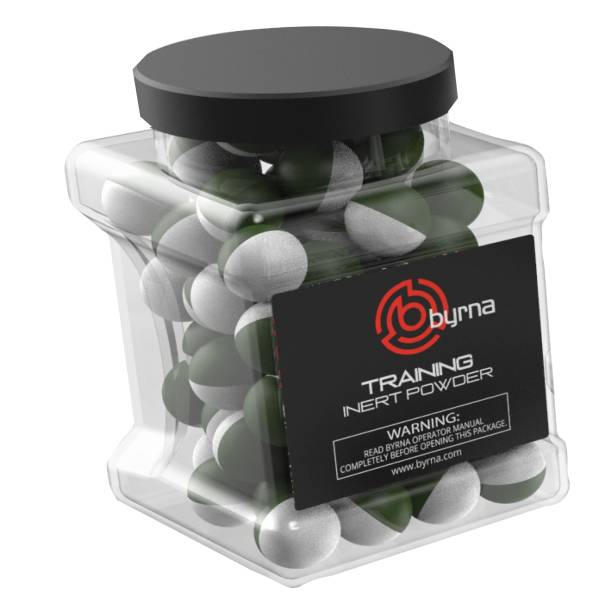Description
.38 Smith & Wesson ammunition has been around for more than a century. And although it has been surpassed in popularity by other cartridges – such as the .38 Special – this S&W ammo is still a great choice for casual target shooting.
In 1877, Smith & Wesson introduced .38 S&W (9x20mm) ammunition designed for its “First Model,” a single action, spur-triggered revolver. Introduced in the 1850s, metallic cartridge revolvers became an overnight success. Most were either large-caliber guns or pocket pistols that used .22 or .32 short loads. The .38 was able to offer more power than the previous rounds, making it more appealing to the military as well as the general public.
A popular cartridge for handguns in its time, the .38 S&W was used most notably by the British military, where it was called .38/200 ammo. This expressed the caliber of the cartridge and the bullet weight in grains. The diameter of the bullet was 0.36 inches, and the overall cartridge length was 1.2 inches, not enough for the .38/200 to perform very well. Muzzle velocity approached 620 feet per second, and muzzle energy was less than 200 foot-pounds.
The .38 S&W is also known as .380 Rim, .38 New Police, Belgian 9mm Revolver, and .38 S&W Corto. Despite the similarities, the round should not be confused with the .38 Special. It is also not interchangeable with the .38 Special due to its shape and diameter.
Though lacking power, the cartridge does have qualities desirable for a good pistol round – including accuracy and reliability with mild recoil. The innovation of .38 Smith & Wesson ammo was using a large-bore cartridge for small- to medium-size revolvers.
.38 S&W ammo is not as popular as it used to be, though at least four major manufacturers still produce the cartridge. Lead round nose bullets are the most common, but it is possible to find full metal jacket bullets and even some hollow point ammo.
The Origins of 38 S&W Ammo
Smith & Wesson changed the face of small defense weapons in the late 19th century when it produced the Safety Hammerless Model, a five-shot top-break revolver, during a time when most guns were edged or single-shot derringers and pistols. The firearm, when fully loaded, weighed less than a pound, and its three-inch barrel was the perfect size to be carried in a gentleman’s coat pocket or a lady’s purse. These pistols, sometimes called “Lemon Squeezers,” were popular for concealed carry, pest control, and plinking.
The gun’s instant success spawned many imitators, and manufacturers throughout Europe began to produce firearms chambered for the .38 S&W round. In the United States, firearms manufacturers appeared overnight, producing knockoffs, some of which were high quality, but some were not. They managed to follow in S&W’s footprints and hit the market with replicas almost as quickly as the real deal. The .38 became a major force in taming the Wild West and was often used as a backup revolver for outlaws and the law that tracked them.
Eventually, the U.S. Cavalry would give the .38 S&W field trials, and it was officially adopted as a service cartridge by Great Britain, most of her former colonies, and Israel during its war for independence. Countless police departments in the U.S. and around the world also adopted the cartridge.
Guns Chambered for .38 S&W ammunition
Smith & Wesson Model 10
The Smith & Wesson Model 10 came into existence in 1899. Since then, it has been known by many names, including the Smith & Wesson .38 Hand Ejector Model, the Smith & Wesson Victory Model, or the Smith & Wesson Military & Police. It is a six-shot, double-action revolver with fixed sights and has been offered with various barrel lengths: 2 inches (51 mm), 3 inches (76 mm), 4 inches (100 mm), 5 inches (130 mm), and 6 inches (150 mm). Barrels of 2.5 inches (64 mm) have been manufactured for special contracts. Experts claim 6,000,000 guns have been produced since its introduction, making it the most popular firearm of the 20th century.
Smith & Wesson focused on other models but returned to manufacturing its M&P series. The company made various cosmetic changes, replaced the frame fitting grip with Magna stocks, and the spring-loaded hammer block safety was replaced with a cam-actuated hammer block. In 1957, to distinguish different models of firearms, S&W began to mark their models with numeric designations. The M&P was renamed as Model 10.
First Model
The First Model M&P of 1899 was a modification of the gun chambered for the .32 caliber bullet, introduced in 1896. The First Model has a six-inch barrel and a free-standing ejector rod without the under-barrel latch popular in later models.
In 1899, the United States military placed large orders with Smith & Wesson for their Model 1899 Hand Ejector revolvers chambered for the .38 Long Colt U.S. Service Cartridge. The order earned the Hand Ejector Model the moniker of the .38 Military and Police Model. Later that year reports from troops in the Philippines were filled with complaints on the ineffectiveness of the round.
As a result, Smith & Wesson made a modification and began offering the M&P with a new chambering, the .38 S&W Special. The new cartridge, which came to be known as the .38 Special, was an elongated version of the .38 Long. When it comes to the 38 Special vs. 38 S&W, the latter increased the weight to 158 grains and the gunpowder charge to 21 grains.
Second Model
In 1902, Smith & Wesson introduced the Second Model, also known as the .38 M&P. The firearms manufacturer made substantial changes to the weapon, which included major modifications to the internal lockwork and a locking mechanism designed to engage the free-standing ejector rod.
Like the previous model, barrels could be purchased in 4-inch, 5-inch, 6-inch, and 6.5-inch lengths. By 1904, S&W offered the .38 M&P in the same sizes – and customers could select a rounded or square butt.
World War I
Large numbers of the M&P revolver were issued throughout World War I. Soldiers preferred it because it was highly reliable and accurate. Despite the popularity of semi-automatic pistols, revolvers remained the weapon of choice because of their reliability and the fact that they were easier and faster to reload.
The end of the war did not dampen sales of the M&P. In fact, the revolver would become a standard-issue sidearm for law enforcement for the next 70 years. It also became a popular choice among civilians. In the 1930s, several new models were introduced, including the first snub-nose revolver, which featured 2-inch, 2.5-inch, and 3-inch barrels.
World War II
From 1942 to 1944, Smith & Wesson M&P military revolvers bore serial numbers with a “V” prefix. They eventually became known as the Smith & Wesson Victory Model. During World War II, more than 500,000 pistols were supplied to the United Kingdom, South Africa, Australia, New Zealand, and Canada under the Lend-Lease program. The Victory Model was the standard-issue sidearm for the U.S. Navy and Marine aircrews, as well as security guards at defense installations and factories throughout the war.
Some units of the United States Armed Forces, including the Coast Guard and Air Force, used the M&P revolvers into the 1990s. Criminal Investigation Division agents used .38 caliber Victory Model revolvers with two-inch barrels. The firearm remained in use by the Air National Guard throughout Operation Desert Storm in 1991 and with U.S. Navy security teams until 1995.
Colt Police Positive L&R
Introduced in 1907, the Colt Police Positive is a six-cylinder, double-action chambered for .32 or .38 caliber cartridges. The gun was designed primarily for law enforcement agencies.
The first issue of the Police Positive was manufactured from 1907 to 1927. The revolver featured Colt’s standard hard rubber grips. The .38 model was offered with 4-inch, 5-inch, and 6-inch barrels.
The second issue ran from 1928 until 1947. Modifications included a heavier frame and a serrated top strap designed to reduce sight glare. Both Police Positive models were based on existing S&W cartridges. Colt made minor adjustments to avoid crediting S&W with the round.
Iver Johnson Hammerless Safety Front
Iver Johnson was a motorcycle and bicycle manufacturer from 1871 to 1993. The company, a rival of Smith & Wesson, produced a top-break revolver known as the Hammerless Safety Front or Safety Automatic, often referred to as the New Model. Despite the gun’s name, the New Model was a revolver and was chambered for .22, .32 Long, and .38 S&W rounds.
British Enfield .38/200 Revolver Cartridge
Manufactured from 1932 to 1957, the Enfield No. 2 was a British top-break revolver chambered for a .38/200 cartridge. The revolver was the standard-issue sidearm used in Great Britain during World War II. It was used alongside the S&W Victory Model as well as the Webley Mk IV.
After World War I, the British Government had determined that the .38 caliber sidearm was a better choice than the .45 due to its reduced recoil. It was imperative to find a substitute that would be equally effective but wouldn’t sacrifice the accuracy necessary in battle. At the time, the .38 S&W round, a 200-grain lead bullet (.38/200 or the .38 Super Police), was popular among the U.S. military as well as civilians. The Government eventually selected a British company, Webley & Scott, as a supplier for their Webley Mk IV revolver.
Popular Culture
From the mafia to assassinations, the .38 S&W has been part of some of society’s most notorious events – including the attempted assassination of two presidents. These are some of its most well-known involvements in pop culture history:
President James Garfield
On July 2, 1881, President James Garfield was at a train station near the U.S. Capitol building in Washington, D.C., when he was shot twice by lawyer Charles Guiteau with a .38 S&W caliber revolver. The weapon, a “Boston Bulldog,” was a cheaply made gun with no known manufacturer. The first shot grazed Garfield’s arm, but the second shot hit the Commander in Chief in the lower torso. President Garfield never lost consciousness and was able to walk away from the train station where he had been shot, but he was killed by an infection of his wounds eighty days later. President Garfield died on September 19, 1881.
President Theodore Roosevelt
On October 13, 1912, New York poet and saloon keeper John Schrank fired his .38 S&W revolver at President Theodore Roosevelt. The bullet hit the President in the chest, where it pierced his left nipple, cracked one of his ribs, and lodged in his chest.
Roosevelt had been prepared to give a lengthy speech, and his long-winded nature, along with the case holding his spectacles, saved his life. The 100-page speech was folded twice and placed in his breast pocket along with his glasses. The items slowed the bullet, saving the President from a fatal end. When the crowd erupted, Roosevelt quickly took charge of the situation by yelling, “Quiet! I’ve been shot.” Roosevelt ignored the interruption and spoke for 90 minutes before going to the hospital.
Doctors later decided that the .38 bullet was embedded too close to Roosevelt’s heart, and therefore, was unsafe to operate. Roosevelt survived but was not re-elected for a third term.
Shrank, who would spend the rest of his life in a mental institution, claimed that he had been ordered to kill the “Bull Moose” by President William McKinley’s ghost. McKinley’s assassination had propelled Roosevelt to his place in the nation’s highest office.
Al Capone
Alphonse Gabriel Capone was a Chicago businessman and notorious gangster who became famous during the Prohibition era and was the co-founder of the Chicago Outfit, a mafia organization. “Scarface” was known to prefer a .38 Police Positive with a 4″ barrel and walnut grips. The gun was confiscated when Capone was arrested for tax evasion. In June 2011, the gun was sold at Christie’s by a private collector, with a sale price of $109,080.
Ironically, it was also a .38 S&W that stopped Capone and ended his seven-year reign as a crime boss. The .38 was owned by Michael Malone, an investigator from the Internal Revenue Service. Malone infiltrated Capone’s gang in the 1930s and was instrumental in collecting the evidence that led to Capone’s arrest and prosecution. Malone’s gun has been a part of the “Follow the Money” exhibit at The Mob Museum, the National Museum of Organized Crime and Law Enforcement in Las Vegas.
Lee Harvey Oswald
On November 22, 1963, U.S. President John Fitzgerald Kennedy was assassinated in Dallas, Texas. While it is widely debated that former U.S. Marine Lee Harvey Oswald pulled the trigger on that day, it is known that he murdered Dallas Police Officer J.D. Tippit later that day. Oswald’s weapon of choice was a rechambered Smith & Wesson Victory Model, which was exported to the United Kingdom as part of the World War II Lend-Lease program. Oswald shot Officer Tippit four times at the point-blank range. The policeman died instantly.
Although not as popular as it once was, 38 S&W ammo was iconic for its time. And with so many guns chambered for this cartridge, it’s hard to imagine that it will ever disappear off the market.





